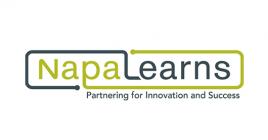Building a Sustainable and Scalable Professional Development Model for Math Teachers with Video Coaching
“I can’t wait for math class!”
Not usually words you hear from an elementary school student. But thanks to the newly implemented Accelerate Math initiative sponsored by NapaLearns, the expression has begun to ring through more halls at Napa Valley Unified School District (NVUSD).
In close partnership with NapaLearns, NVUSD is implementing the Accelerate Math program with five schools, fifty-three teachers, and fifteen-hundred students to increase proficiency in inquiry-based mathematics. NVUSD adopted The Math Learning Center curriculum, Bridges, which requires a fundamental shift in teaching practice. Students are taught to think visually by using manipulatives and collaborating with their student peers as a way of opening up their learning experience.
The first step in supporting this curriculum and mindset change for students is to invest heavily in professional development and coaching for their teachers. This is where Edthena enters the picture.

We recently had a (video-based) conversation with Barb Corna, the lead Academic Specialist at Northwood Elementary School for the Accelerate Math program.
How did you go from math teacher into a math instructional coach?
I’m currently an Academic Specialist, which is a coach for Napa Valley Unified School District. I’ve been teaching for 28 years. Of that, 26 have been in the classroom, and the last two have been in this Academic Specialist role.
Because of my math background, NapaLearns tapped me for this job to support teachers in the methodology and techniques of visually teaching math to students. Working in teams, using manipulatives — these are strategies that we are trying to implement. And, in fact, this curriculum actually aligns well with Common Core.
What are examples of things that your teachers have learned through their use of video reflection?
One great thing about video is that it is a private way for a teacher to watch their lesson. In Edthena, the teacher can share their video with only the people that he or she wants to see the video. This is beneficial because it gives them an opportunity to watch the actual lesson and reflect on their own. I believe teachers can learn a lot by revisiting their teaching because they can see their classrooms from a different perspective.
They can catch quirks about their teaching styles and make sure to keep that in mind for their next lessons. I have used video before. When I was videotaping myself, I noticed a lot of things I would not normally see. After watching yourself, you realize what you can do to improve your next lesson.
As a coach, why have you started utilizing classroom video feedback to support your teachers?
We are looking for a sustainable and scalable model. This is where video coaching comes in. The idea is for teachers to videotape themselves and then share it with their colleagues asking for specific feedback.
Being able to leave timestamped comments has allowed us to create conversations at the specific point in time that we want the teacher to reflect on. This year, we will use video as an informal look at the level of math conversations going on in their classrooms.
Overall, the Edthena platform allows me a chance to point out missed opportunities and suggestions: “What might you do next time…?” “Could you have asked a follow-up question?” “Did you wait to ensure the students’ ideas influenced the lesson?” These questions that coaches leave create a conversation, so the teacher reflects on their practice.
The video is a way for you to actually see what you’re doing and how your students are reacting to you. A teacher may have an idea of how they appear, but then there’s, of course, the reality of how their students react.
What are your recommendations for someone starting to use video observation for teacher professional development?
Something I have found helpful is to record group work. If you’re using an iPad or phone, the microphone can be limited which makes it difficult to hear all of the comments from the entire class.
By targeting a specific group of students, teachers can really notice how the students are responding to their instruction. You can actually get just as much out of watching what the kids are doing as watching what you are teaching.
Watch our full interview (7 minutes) in the video above.


